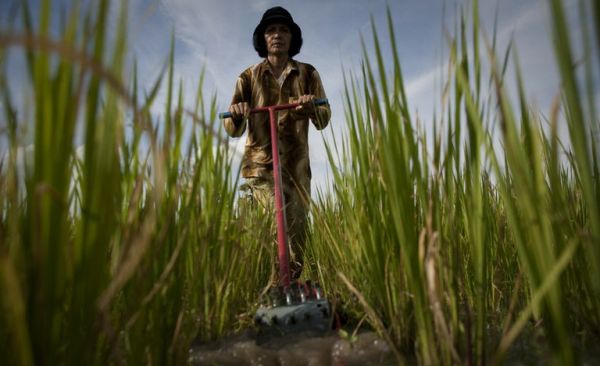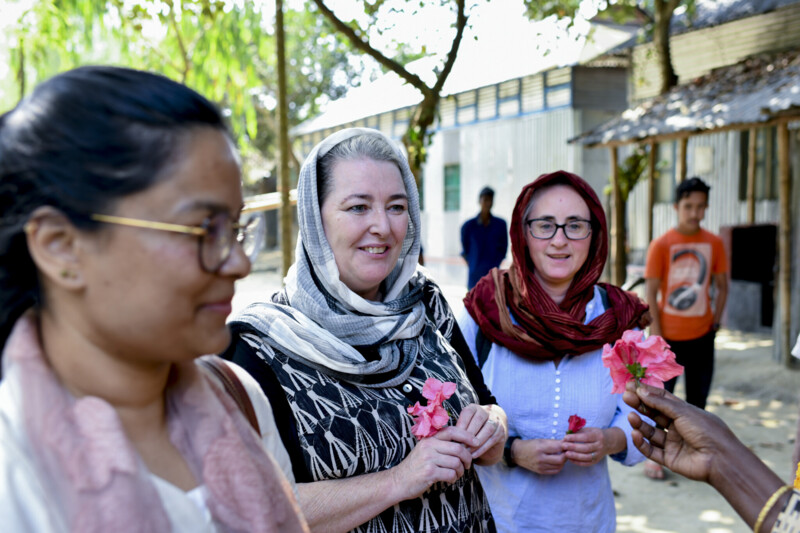By Chris Hufstader, Oxfam America
When Sorn Ken weeds her rice fields, she likes to have company. Her sister So Van helps her in her field, and Sorn will help So in hers. “We chitchat, and when we get tired we take a rest and keep chitchatting,” she says at the edge of her sister’s field. “It’s kind of fun to weed the field with others.”
Sorn says she spends less time weeding her fields than she used to since she started using a mechanical weeding device she helped create with assistance from Oxfam’s partner in Cambodia, RACHANA, an organisation based in the southern Takeo province. When farmers use this new tool, they can accomplish in a few hours what used to take them many days.
Oxfam supported RACHANA in designing and testing the mechanical weeders that help farmers grow more rice. Switching to innovative rice-growing systems and using a mechanical weeder can create more than 100% gains in production—a huge improvement for small-scale rice growers like Sorn and her sister.
Supporting innovation
Sorn is among 100 families in the area growing rice using an array of special methods called the System of Rice Intensification, or SRI. SRI represents an accessible form of innovation for small-scale farmers like Sorn: it boosts yields through different ways of plowing fields and improving soil fertility, and of planting and transplanting rice. SRI helps the plants grow stronger and more resistant to pests and diseases. It doesn’t require special seed varieties. And because the plants are healthier, the farmers need less fertiliser and pesticides, which saves them money and preserves the environment.
One of SRI’s techniques involves transplanting single seedlings farther apart, instead of transplanting them in bunches. The distance helps seedlings grow stronger roots. SRI farmers plant their seedlings in rows, so they can weed around the plants more easily. A mechanical weeder helps them speed up the process.
In Sorn’s village of Prey Pa’e, RACHANA found a metalworker named Ben Pen who was willing to work with the local farmers to develop the weeders. With RACHANA’s help, he began to adapt designs from India and other countries in 2009; he optimised them based on feedback from women farmers. Sorn and about 20 others tested five prototypes. With Pen, they developed one- and two-wheel weeders, which farmers use for different soil and weed conditions. The weeders weigh between 1.8 and 5.5kg. Each of them has a long handle with which the farmers push narrow wheels with steel spikes, churning the earth and tearing up the weeds.
Most of the farmers responsible for testing the weeders were women. Though men help prepare the soil and assist with the harvest, women do most of the work in the fields. Pen and RACHANA wanted to make sure that the weeder designs are suitable for them. “These weeders are helping women avoid back pain, and neck pain,” Pen says. “They can stand up, and it’s a lot faster.”
‘Quite a difference’
Sorn moves down the rows between the rice plants pushing the weeder in front of her like a lawn mower. The tool splashes through a thin layer of water, cutting up clumps of grass and mud.
“There’s quite a difference when you use the weeding tools,” Sorn says. “If you weed by hand you only get the top of the weed, you don’t get the root, and it grows again. When you use the weeding tool, it destroys the root and churns the weed into the soil—it’s better for the soil.”
Having the weeder helps Sorn and her sister get their weeding done faster. She says saving this time and labor is particularly important for her now: her husband passed away and her six children are all grown and have left the village to work and study. She’s 55, alone, and needs the help.
RACHANA’s research showed that by combining weeders with SRI, farmers could increase their production dramatically. The organisation ordered 900 of the three most popular weeders from Pen; it is selling them to farmers across the country. The tools cost about USD $20 — a significant investment, prompting groups of two or three neighbours to buy the tools together and share them.
The investment is worth the time saved: the women in Prey Pa’e say it takes three people two weeks to weed a hectare, and by the time they finish, the weeds are already growing again. “With the weeder, three people can finish in one morning,” says Pen Rat, who was part of the prototype testing team.
Sorn says she helped Test the one-wheel weeder, and suggested that Pen lower the angle of the handle, so women would be pushing at waist level. “I thought women would have more strength to push and pull,” she says.
Simple forms of innovation, like these mechanical weeders, encourage farmers to come together, share their ideas, and play a role in developing technological improvements for their farming. This type of endeavor is just a small part of Oxfam’s work to transform agriculture for the poorest farmers in Cambodia.
Farmers like Sorn Ken confirm this: “Having this weeder is like having another person,” she says.
Learn more
Find out more about Oxfam’s work in Cambodia



